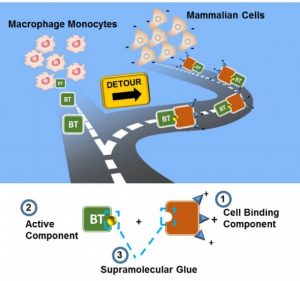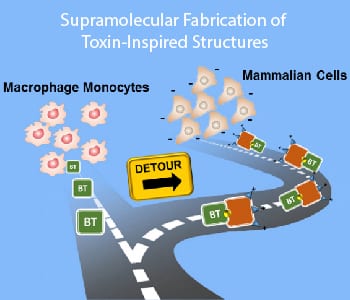Bacterial exotoxins (BTs), such as anthrax or botulinum neurotoxins, are nature’s most efficient weaponry because these protein toxins are enzymes that enter mammalian cells and modify cellular molecules that mediate essential functions. This results in severe and life-threatening human and animal diseases that are characteristic for each individual toxin. One molecule of these toxins is in principle sufficient to essentially damage the cell. Their potency is attributed to the highly refined modular structures: Each individual domain of BTs has been tuned by nature to achieve cellular uptake with amazing efficacy and cell-type specificity. Once taken up, BTs interfere with specific biochemical processes such as the inhibition of protein synthesis. Due to these unique features, BTs have been harnessed to address various diseases including cancers. Genetic engineering has been applied to produce recombinant BTs with several optimized features. However, relying on the protein machinery of cells limits the design of even more sophisticated BTs with better prospective for therapeutic purposes. In particular, the combination of functional synthetic components with BT protein domains offers immense potential to evolve BT enzymes beyond their innate abilities.

Toxin-Inspired Macromolecules Fabricated by Supramolecular Engineering and Rerouting of BT Enzymes into Mammalian Cells
Prof. T. Weil and her team from Ulm University have devised a bottom-up approach to fabricate precisely arranged synthetic macromolecules and an enzymatically active toxin from Clostridium botulinum by applying concepts of programmed self-assembly and biomolecular chemistry. They adopted a strategy inspired by the evolutionary design of native BTs and their functional components and arranged the three key features namely (1) a cellular membrane binding part, (2) a catalytically active domain and (3) a supramolecular glue for precisely connecting the two functional domains.
Here, they used the strong affinity of vitamin H with its natural binding protein as the supramolecular glue. A synthetic, macromolecular entity, amine-terminated dendrons, served as efficient cell-binding domain providing attractive electrostatic interactions. The catalytic domain of the highly specific, Rho-protein inhibiting BT “C3”, was selected and bound through the supramolecular glue to give the modular cell-penetrating C3 protein-dendron hybrid that mimics the modular, precisely arranged architecture of natural BT. The novel features conferred by the synthetic dendron entities overcome the low uptake of the toxin enzyme into mammalian cells and has the potential to address a broad spectrum of diseases.

















